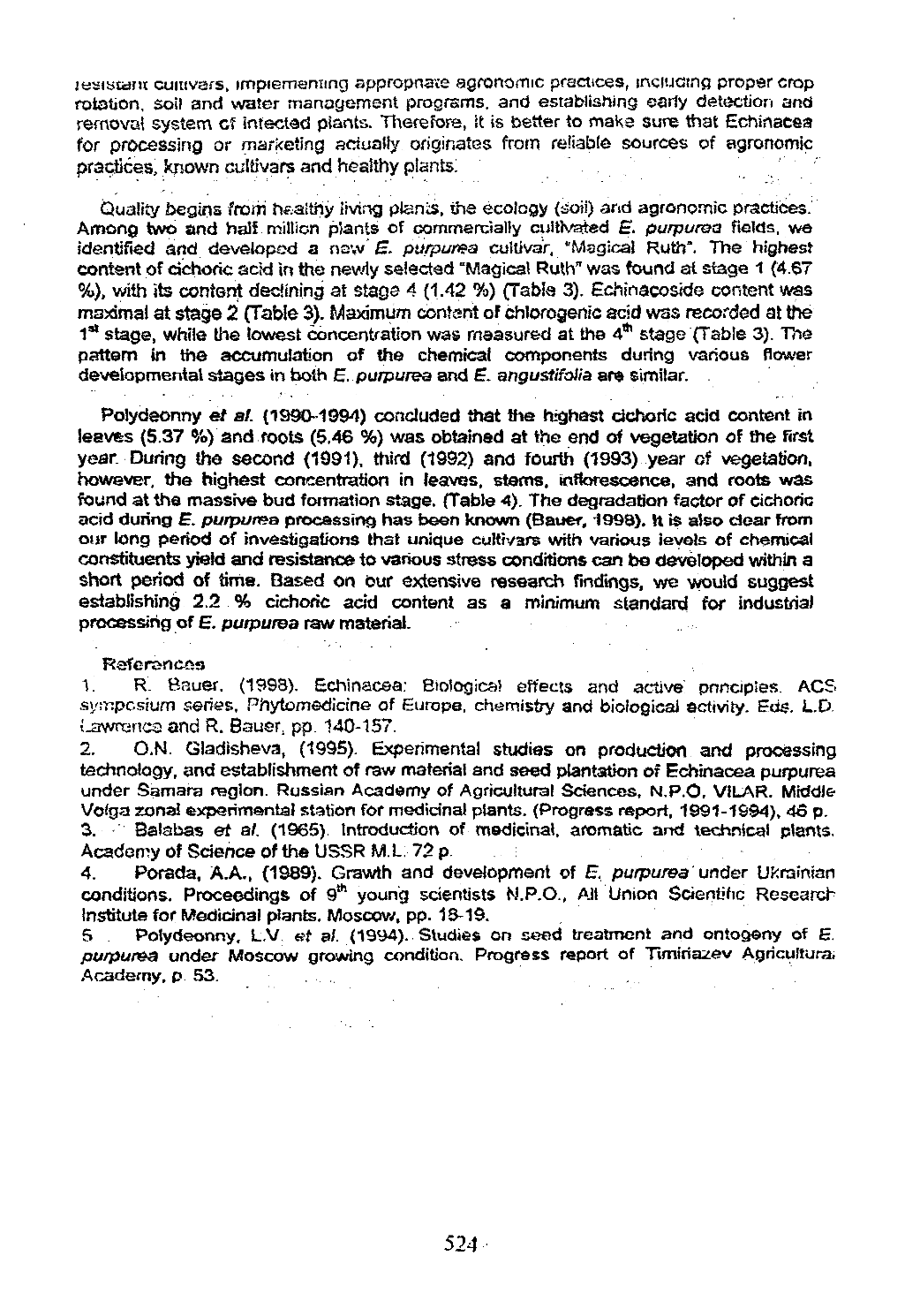

lesistoni cuiuvars, implementing appropriate agronomic practices, including proper crop
rotation, soil and water management programs, and establishing early detection and
removal system c? infected plants. Therefore, it is better to make sure that Echinacea
for processing or marketing actually originates from reliable sources of agronomic
practices, known cultivate and healthy plants.
Quality begins from healthy living pisnis, the ecology (soii) and agronomic practices.
Among two and half million plants of commercially cultivated £
purpurea
fields, we
identified and developed a now £
purpurea
cuUivar. **Magical Ruth”. The highest
content of cichoric acid in the newly selected “Magical Ruth” was found at stage 1 (4.67
%), with its content declining at stage 4 (1.42 %) (Table 3). Eehinacoskfe content was
mammal at stage 2 (Table 3). Maximum content of chlorogenic add was recorded at the
1я* stage, while the lowest concentration was measured at the 4 * stage (Table 3). The
pattern in the accumulation of the chemical components during various flower
developmental stages in both £
purpurea
and £
angustifoiia
are similar.
Polydeonny
at at.
(19901 994 ) concluded that the highest cichoric ad d content in
leaves (5.37 %) and roots (5.46 %) was obtained at the end of vegetation of the first
year. During the second (1991). third (1992) and fourth (1993) year of vegetation,
however, the highest concentration in leaves, stems, inflorescence, and roots was
found at the massive bud formation stage. (Table 4). The degradation factor of cichoric
acid during £
purpurea
processing has been known (Bauer, 1998). ft is also d ear from
our long period of investigations that unique cultivate with various levels of chemical
constituents yield and resistance to various stress conditions can be developed within a
short period of time. Based on our extensive research findings, we would suggest
establishing 2.2 % cichoric add content as a minimum standard for industrial
processing of £
purpurea
raw material.
References
1.
R- Bauer. (1998). Echinacea: Biological effects and active principles. ACS
.symposium series, Fhytomedicine of Europe, chemistry and biological activity. Eds. L.0
i-awrence and R.
Bauer,
pp. 140-157.
2.
O.N. Gladisheva, (1995). Experimental studies on production and processing
technology, and establishment of raw material and seed plantation of Echinacea purpurea
under Samara region. Russian Academy of Agricultural Sciences, N.P.O, V1LAR. Middle
Volga zonal experimental station for medicinal plants. (Progress report, 1991-1994), 43 p.
3.
Balabas ef a/. (1965) Introduction of medicinal, aromatic and technical plants.
Academy of Science of the USSR M L 72 p
4.
Porada,
A.AM(1989). Grawth and development of £
purpurea
under Ukrainian
conditions. Proceedings of 9th young scientists M.P.O., All Union Scientific Research
Institute for Medicinal plants. Moscow, pp. 13-19.
6»
Polydeonny, L.V. ef
af.
(1994). Studies on seed treatment and ontogeny of E.
purpurea
under Moscow growing condition. Progress report of Timiriazev Agriculture*
Academy, p 53.
524
Научная электронная библиотека ЦНСХБ









